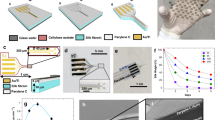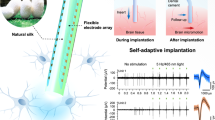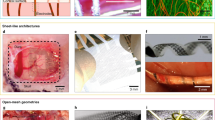Abstract
Electronics that are capable of intimate, non-invasive integration with the soft, curvilinear surfaces of biological tissues offer important opportunities for diagnosing and treating disease and for improving brain/machine interfaces. This article describes a material strategy for a type of bio-interfaced system that relies on ultrathin electronics supported by bioresorbable substrates of silk fibroin. Mounting such devices on tissue and then allowing the silk to dissolve and resorb initiates a spontaneous, conformal wrapping process driven by capillary forces at the biotic/abiotic interface. Specialized mesh designs and ultrathin forms for the electronics ensure minimal stresses on the tissue and highly conformal coverage, even for complex curvilinear surfaces, as confirmed by experimental and theoretical studies. In vivo, neural mapping experiments on feline animal models illustrate one mode of use for this class of technology. These concepts provide new capabilities for implantable and surgical devices.
This is a preview of subscription content, access via your institution
Access options
Subscribe to this journal
Receive 12 print issues and online access
$259.00 per year
only $21.58 per issue
Buy this article
- Purchase on SpringerLink
- Instant access to full article PDF
Prices may be subject to local taxes which are calculated during checkout





Similar content being viewed by others
Change history
23 April 2010
In the original published versions of this Article the author list was incorrect. This has now been corrected in both the full-text HTML and the PDF versions.
References
Kim, S. et al. Integrated wireless neural interface based on the Utah electrode array. Biomed. Microdevices 11, 453–466 (2009).
Ryu, S. I. & Shenoy, K. V. Human cortical prostheses: Lost in translation? Neurosurg. Focus 27, E5 (2009).
Andersen, R. A., Musallam, S. & Pesaran, B. Selecting the signals for a brain–machine interface. Curr. Opin. Neurobiol. 14, 720–726 (2004).
Mehring, C. et al. Inference of hand movements from local field potentials in monkey motor cortex. Nature Neurosci. 6, 1253–1254 (2003).
Ball, T. et al. Towards an implantable brain–machine interface based on epicortical field potentials. Biomed. Tech. 49, 756–759 (2004).
Wilson, J. A., Felton, E. A., Garell, P. C., Schalk, G. & Williams, J. C. ECoG factors underlying multimodal control of a brain–computer interface. IEEE Trans. Neural Syst. Rehabil. Eng. 14, 246–250 (2006).
Freeman, W. J., Rogers, L. J., Holmes, M. D. & Silbergeld, D. L. Spatial spectral analysis of human electrocorticograms including the alpha and gamma bands. J. Neurosci. Methods 95, 111–121 (2000).
Kellis, S. S., House, P. A., Thomson, K. E., Brown, R. & Greger, B. Human neocortical electrical activity recorded on nonpenetrating microwire arrays: Applicability for neuroprostheses. Neurosurg. Focus 27, E9 (2009).
Rubehn, B., Bosman, C., Oostenveld, R., Fries, P. & Stieglitz, T. A MEMS-based flexible multichannel ECoG-electrode array. J. Neural Eng. 6, 036003 (2009).
Hollenberg, B. A., Richards, C. D., Richards, R., Bahr, D. F. & Rector, D. M. A MEMS fabricated flexible electrode array for recording surface field potentials. J. Neurosci. Methods 153, 147–153 (2006).
Yu, Z. et al. Monitoring hippocampus electrical activity in vitro on an elastically deformable microelectrode array. J. Neurotrauma 26, 1135–1145 (2009).
Meacham, K. W., Giuly, R. J., Guo, L., Hochman, S. & DeWeerth, S. P. A lithographically-patterned, elastic multi-electrode array for surface stimulation of the spinal cord. Biomed. Microdev. 10, 259–269 (2008).
Lawrence, B. D., Cronin-Golomb, M., Georgakoudi, I., Kaplan, D. L. & Omenetto, F. G. Bioactive silk protein biomaterial systems for optical devices. Biomacromolecules 9, 1214–1220 (2008).
Omenetto, F. G. & Kaplan, D. L. A new route for silk. Nature Photon. 2, 641–643 (2008).
Jin, H-J. et al. Water-stable silk films with reduced β-sheet content. Adv. Funct. Mater. 15, 1241–1247 (2005).
Lu, Q. et al. Water-insoluble silk films with silk I structure. Acta Biomater. 6, 1380–1387 (2009).
Jiang, C. et al. Mechanical properties of robust ultrathin silk fibroin films. Adv. Funct. Mater. 17, 2229–2237 (2007).
Sofia, S., McCarthy, M. B., Gronowicz, G. & Kaplan, D. L. Functionalized silk-based biomaterials for bone formation. J. Biomed. Mater. Res. 54, 139–148 (2001).
Perry, H., Gopinath, A., Kaplan, D. L., Negro, L. D. & Omenetto, F. G. Nano- and micropatterning of optically transparent, mechanically robust, biocompatible silk fibroin films. Adv. Mater. 20, 3070–3072 (2008).
Murphy, A. R., John, P. S. & Kaplan, D. L. Modification of silk fibroin using diazonium coupling chemistry and the effects on hMSC proliferation and differentiation. Biomaterials 29, 2829–2838 (2008).
Altman, G. H. et al. Silk-based biomaterials. Biomaterials 24, 401–416 (2003).
Santin, M., Motta, A., Freddi, G. & Cannas, M. In vitro evaluation of the inflammatory potential of the silk fibroin. J. Biomed. Mater. Res. 46, 382–389 (1999).
Kim, D-H. et al. Silicon electronics on silk as a path to bioresorbable, implantable devices. Appl. Phys. Lett. 95, 133701–133703 (2009).
Amsden, J. J. et al. Spectral analysis of induced colour change on periodically nanopatterned silk films. Opt. Express 17, 21271–21279 (2009).
Parker, S. T. et al. Biocompatible silk printed optical waveguides. Adv. Mater. 21, 2411–2415 (2009).
Soong, H. K. & Kenyon, K. R. Adverse reactions to virgin silk sutures in cataract surgery. Ophthalmology 91, 479–483 (1984).
Chaudhury, M. K. & Whitesides, G. M. Direct measurement of interfacial interactions between semispherical lenses and flat sheets of poly(dimethylsiloxane) and their chemical derivatives. Langmuir 7, 1013–1025 (1991).
Someya, T. et al. Conformable, flexible, large-area networks of pressure and thermal sensors with organic transistor active matrixes. Proc. Natl Acad. Sci. USA 102, 12321–12325 (2005).
Padnick, L. B. & Linsenmeier, R. A. Properties of the flash visual evoked potential recorded in the cat primary visual cortex. Vision Res. 39, 2833–2840 (1999).
Cardin, J. A., Palmer, L. A. & Contreras, D. Stimulus feature selectivity in excitatory and inhibitory neurons in primary visual cortex. J. Neurosci. 27, 10333–10344 (2007).
Cardin, J. A., Palmer, L. A. & Contreras, D. Cellular mechanisms underlying stimulus-dependent gain modulation in primary visual cortex neurons in vivo. Neuron 59, 150–160 (2008).
Acknowledgements
We thank T. Banks and J. A. N. T. Soares for help using facilities at the Frederick Seitz Materials Research Laboratory. This material is based on work supported by a National Security Science and Engineering Faculty Fellowship and the US Department of Energy, Division of Materials Sciences under Award No. DEFG02-91ER45439, through the Frederick Seitz MRL and Center for Microanalysis of Materials at the University of Illinois at Urbana-Champaign. The aspects of the work relating to silk are supported by the US Army Research Laboratory and the US Army Research Office under contract number W911 NF-07-1-0618 and by the DARPA-DSO and the NIH P41 Tissue Engineering Resource Center (P41 EB002520). Work at the University of Pennsylvania is supported by the National Institutes of Health Grants (NINDS RO1-NS041811-04, R01 NS 48598-04), and the Klingenstein Foundation. J.A.R. is supported by a National Science Security and Engineering Faculty Fellowship.
Author information
Authors and Affiliations
Contributions
D-H.K., J.V., J.J.A., J.X., L.V., Y-S.K., D.C., D.L.K., F.G.O., Y.H, K-C.H., M.R.Z., B.L. and J.A.R. designed the experiments. D.H.K., E.S.F., J.V., J.J.A., J.X., L.V., Y-S.K., B.P. and J.A.B. carried out experiments and analysis. D-H.K., J.V., J.J.A., J.X., L.V., J.A.B., D.C., D.L.K., F.G.O., Y.H., B.L. and J.A.R. wrote the paper.
Corresponding authors
Ethics declarations
Competing interests
The authors declare no competing financial interests.
Supplementary information
Supplementary Information
Supplementary Information (PDF 1105 kb)
Rights and permissions
About this article
Cite this article
Kim, DH., Viventi, J., Amsden, J. et al. Dissolvable films of silk fibroin for ultrathin conformal bio-integrated electronics. Nature Mater 9, 511–517 (2010). https://doi.org/10.1038/nmat2745
Received:
Accepted:
Published:
Issue Date:
DOI: https://doi.org/10.1038/nmat2745



